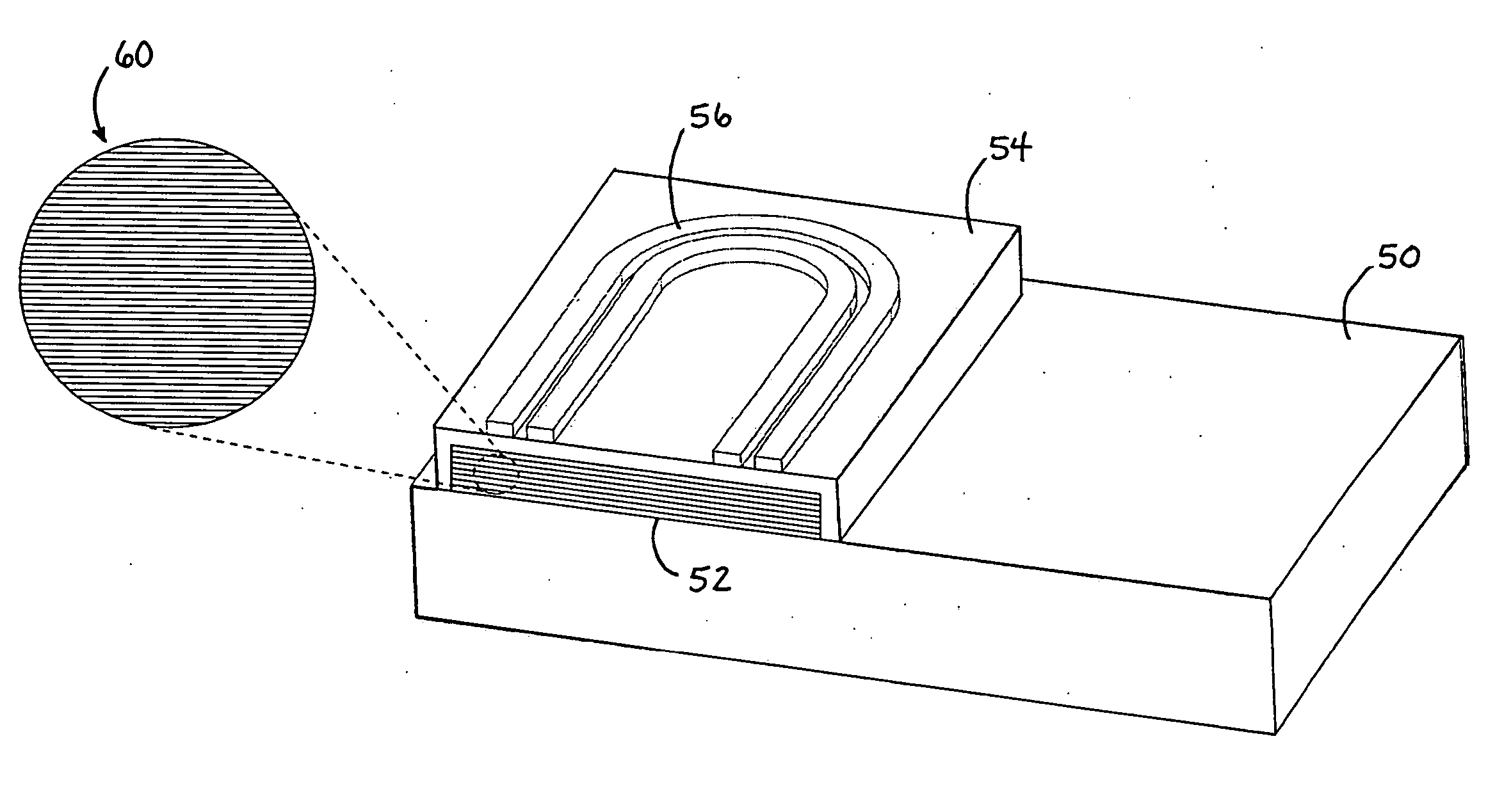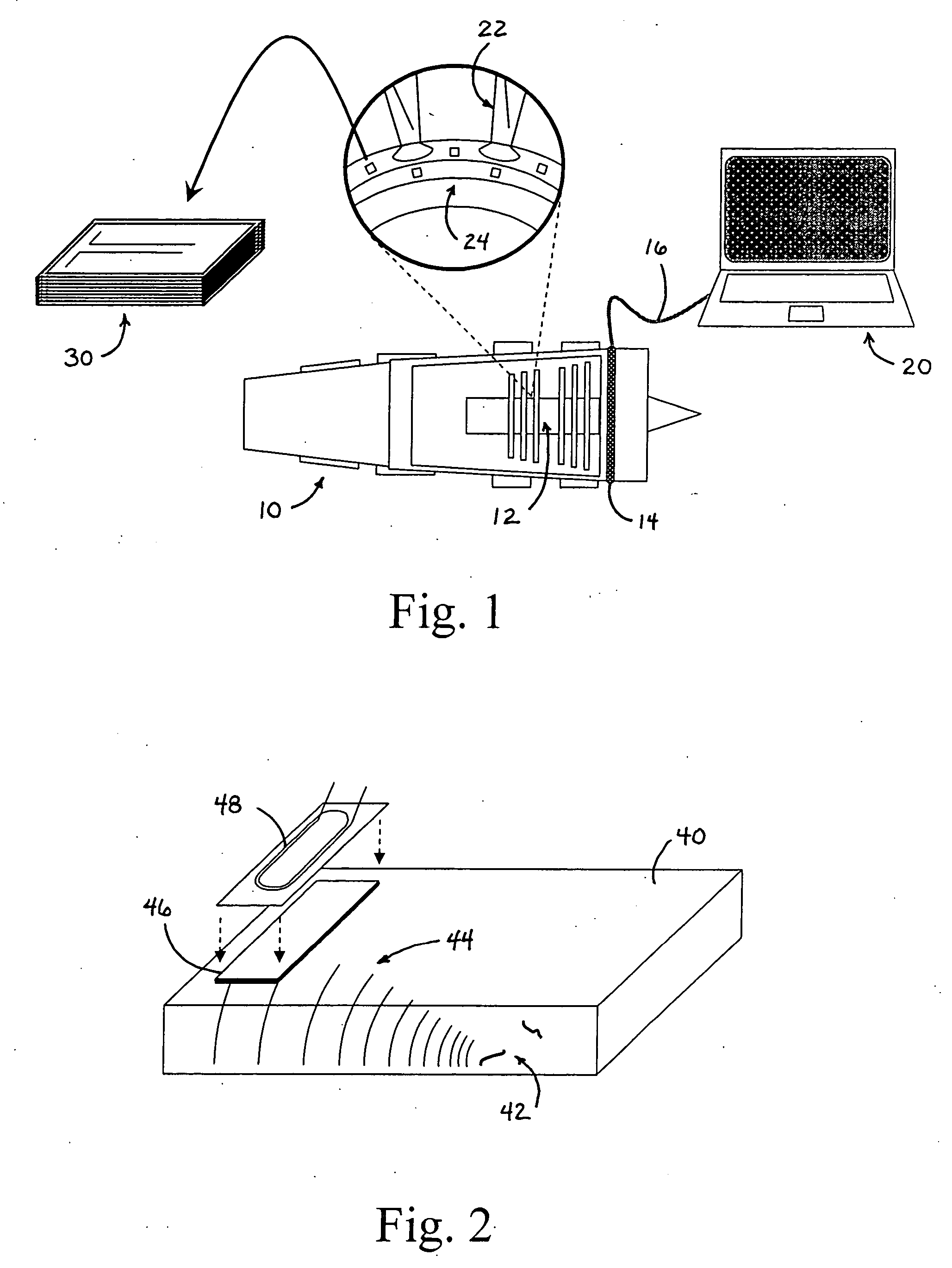[0013] One embodiment (that forms the basis of the present invention) for using embedded sensors in association with a
system for monitoring a
turbine engine disc is illustrated in FIG. 1. The
system as generally shown includes a plurality of sensors 30 (as described in greater detail below) that are placed (for example) near fracture critical components such as
turbine blades 22 and
turbine discs 24. These sensors 30 positioned on the moving components 12 of turbine engine 10 are in wireless RF
signal connection to a receiving antenna 14 positioned on a stationary component of engine 10. Antenna 14 is connected through a
signal line 16 to
data processing instrumentation 20 for
signal analysis. This concept includes distributed thin-film magnetostrictive sensors that are integrated onto the component surface near fracture critical locations (FCLs). Periodically activating the thin-film sensors by generating ultrasonic
waves enables interrogation of the material component for defects through the detection of
reflected waves from the defect using the “pulse-echo” mode of detection. The complete
sensor system concept also includes a fully
integrated antenna for the harvesting of energy using microwaves (or other frequency electromagnetic
waves) thereby providing power for sensor activation and
radio frequency (RF) communication of the backscattered ultrasonic signals. This fully integrated, monolithic, wireless, self-powered crack detection sensor provides effective structural health management and prognosis in turbine engines, as well as other high-value assets.
[0014] A thin-film sensor form factor offers unique advantages over other
detector architectures in terms of performance and integration simplicity (a relatively simple architecture for monolithic surface integration),
mass-production compatibility to micro-system manufacturing processes, and durability under the severe challenges posed by high-temperature operating environments. In theory, several thin-film materials and associated physical phenomenon are possible including magnetostrictive (Ms), piezoelectric, or shape memory, all of which can be deposited as thin films. However, magnetostrictive thin films are seen as providing one of the best
modes for structuring a sensor for use in the system of the present invention since they offer several attractive features: a) a
high energy output for remote-control actuation and communication, b) a wide range of candidate material systems (and associated process flexibility to meet end-use requirements), and c) inherent durability and robustness.
[0017] The method for manufacturing the engineered, monolithically integrated, multi-layered (nano-composite), thin-
film structure includes a number of customizing factors including the magnetron
sputtering (or vapor deposition) of alternating
layers of a high (hard) magnetostrictive material (iron /
rare earth or similar
alloy) and a high
magnetization (soft) material (FeCo or similar) directly onto sensing platform or onto a flexible backing substrate that can later be affixed to sensing platform. Composite magnetostrictive layer properties, such as
magnetostriction coefficient, saturation
magnetization, and
Curie temperature (
thermal stability), can be engineered by adjusting layer thicknesses (2 nm-50 nm), soft / hard layer ratio (typically greater than 1) and
sputtering deposition parameters (with and without
ion assist and / or RF sample bias) with minimum total layered composite thickness such that losses due to
skin depth effects are minimized (typically greater than 3 microns). Composite magnetostrictive
layers can also be post-annealed in a magnetic
bias field or annealed in-situ as part of elevated temperature service to enhance performance.
[0021] A further important aspect of the manufacturing process may include steps in which the magnetic spin orientation is engineered, thereby eliminating the need for magnetic biasing with permanent magnets prior to activation, or during operation. The manufacturing method may also include steps in which the
dielectric layer and activation layer are deposited by methods other than magnetron
sputtering, such as other PVD, wet chemical, or
plasma /
flame spray techniques. Other types of magnetostrictive materials (other than iron-based) may also be substituted to achieve specific properties or enhance actuation performance.
 Login to View More
Login to View More 


